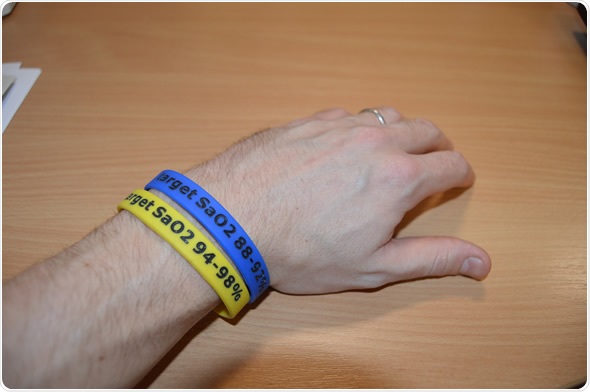What do healthcare professionals currently use to make sure that they administer the correct amount of oxygen to a patient?
Oxygen is delivered with variable flows that administer different concentrations. National guidelines were published in 2009 that provide recommendations about prescribing the oxygen and titrating it to certain target ranges. The problem has been that, despite much effort by respiratory physicians like myself, it's been difficult to roll that out across the country and compliance has never been much more than about 50% on annual audits.

Why have the national guidelines been difficult to roll out?
I think it’s been difficult to roll out because it represents quite a big cultural change within healthcare. Oxygen has always been perceived as a life-saving agent and never thought of as particularly harmful, except in a very small subgroup of patients.
However, there's increasing evidence that even in patients who haven't got chronic respiratory disease, over-oxygenation may also pose a danger.
When people are severely ill and breathless, the knee-jerk response is to give them oxygen and that might not necessarily be the right thing to do. It's embedded in the culture of medical students, doctors, nurses and paramedics, which makes the change hard to implement.
Why can excessive amounts of oxygen be dangerous for some patients?
We've known for a long time that oxygen can be dangerous when used to treat patients with chronic respiratory disease. Because they have respiratory failure, the way they manage their respiratory rate is dependent on how much oxygen they have in their bloodstream. If you give them oxygen, it depresses their respiratory rate, which can lead to a build-up of dangerous amounts of carbon dioxide.
A 2012 study published in the BMJ looked at patients with COPD who were administered oxygen while on their way to hospital and the oxygen was either titrated or uncontrolled. That study showed a significant increased mortality rate and increased length of hospital stay among patients who had uncontrolled oxygen on the way to hospital.
More recently, one study looking at ST elevation myocardial infarction showed that people who received high concentrations of oxygen had more cardiac damage at 6 weeks after the event than those who received no oxygen. The same also applied to stroke patients. There was some interest in stroke over whether giving patients oxygen might protect the brain, but the converse was shown. Patients who didn't have low oxygen levels but were given oxygen anyway, were shown to have a higher mortality rate.
Although originally the concerns were about respiratory disease, it seems it’s not only this patient group who are harmed by oxygen administration. There must be something about increasing the oxygen dissolved in the blood that causes tissue damage. There are lots of theories behind that, but nobody really knows the answer.
How did you come up with the idea of using colour-coded wristbands to identify how much oxygen each patient needs?
We've been trying locally in my hospital to improve oxygen titration for quite a while. We were doing quite well and then an electronic prescribing system was introduce, which meant that oxygen prescription was no longer on a chart at the end of the bed; it was on a computer which required a password to log in and that was only available to the medical and the nursing staff. The oxygen prescription wasn't easily available to the heathcare assistance who were measuring the oxygen saturations. They would measure the target saturations but they wouldn't know what the range was for that specific patient and therefore more patients were not getting the right treatment.
Then I saw a patient in clinic who had a charity wristbands on and it was one of those eureka moments. It occurred to me that they would work. At that time I was dealing with this problem of how to make the prescription obvious and clear to the people who are recording the observations.
How many different colours are there?
We have three. There are two for prescribed ranges and then one for people who need a very specific range.
In which hospitals have the wristbands been trialled and what feedback have you received from hospital staff, paramedics and patients?
Currently, we've only tried them locally at the Royal Derby, but we're starting up a project across three other trusts in the East Midlands in Leicester, Nottingham, and Mansfield. At the Royal Derby, compliance improved so that up to about 85% of patients having oxygen prescribed are in the target range.
Your team recently won an East Midlands Innovation in Healthcare Award for this project. What impact do you think this will have?
It's had a big impact already. It's opened doors and has raised the profile. We have some money as a result of the prize, which means that we can roll out across those other three trusts. It's very difficult to get innovation or change rolled out, even locally. The prize helps in terms of raising the profile and getting though barriers.
How do you plan to use the £2,000 prize?
We’re going to use the money to roll out to the other three trusts, which will hopefully start using the wristbands in April. The East Midlands ambulance service are also quite interested in the project because one big benefit is that if we can identify patients who are at danger of over oxygenation on their way to hospital, we might be able to save some lives.
A lot of patients said they didn't realize that oxygen could be dangerous and they think the wristbands are great. They've been ringing up our home oxygen service and asking for the wristbands because it's been in the local press. They're real advocates and really powerful in terms of bringing about change.
The wristbands give patients confidence to challenge to health professionals about the use of oxygen when they come into hospital. This is something I don't anticipate and potentially a really powerful tool for change. It's very easy for patients and cares to see; there's no mixed message.
Raising awareness among patients that oxygen can be dangerous is something that the British Thoracic Society has been trying to do for quite some time. There's a lot of publicity for cardiac disease and cancer, but respiratory disease, which is originally where we thought the over oxygenation was a problem, has not been given a lot of air time. However, the emerging evidence that it's also a problem in other areas might help promote awareness.
What are your future plans for this project?
We're hoping that the roll out across the other three trusts will show similar improvements to the ones we saw here in Derby. It would be nice to think that if we've shown it works on a regional basis, we could try and get it rolled out across the country. That would be the best result.
Where can readers find more information?
The East Midlands Academic Health and Science Network certainly has information about the prize. They are facilitating the project with the East Midlands Respiratory Network and both the networks have websites where there will be information.
About Dr Gillian Lowrey
 Dr Gillian Lowrey is a Consultant in Respiratory Medicine at The Royal Derby NHS Foundation Trust. She is lead for the oxygen service and is working with the East Midlands Respiratory Network on quality improvement projects to improve the use of oxygen in the acute setting. She has a special interest in COPD and completed a MD in 2009. She is a member of the Secondary Care Steering Group for the RCP National COPD Audit programme and has sat on the BTS Specialist Advisory Group for COPD.
Dr Gillian Lowrey is a Consultant in Respiratory Medicine at The Royal Derby NHS Foundation Trust. She is lead for the oxygen service and is working with the East Midlands Respiratory Network on quality improvement projects to improve the use of oxygen in the acute setting. She has a special interest in COPD and completed a MD in 2009. She is a member of the Secondary Care Steering Group for the RCP National COPD Audit programme and has sat on the BTS Specialist Advisory Group for COPD.